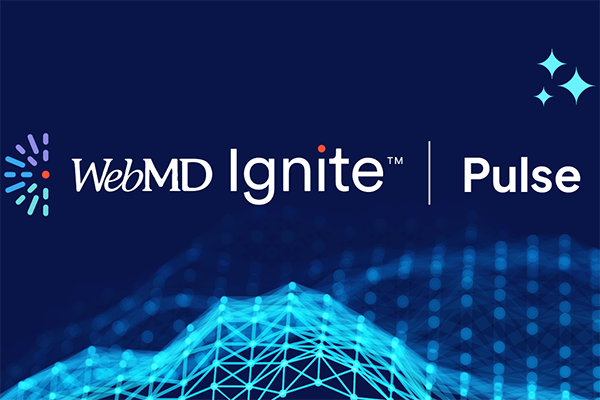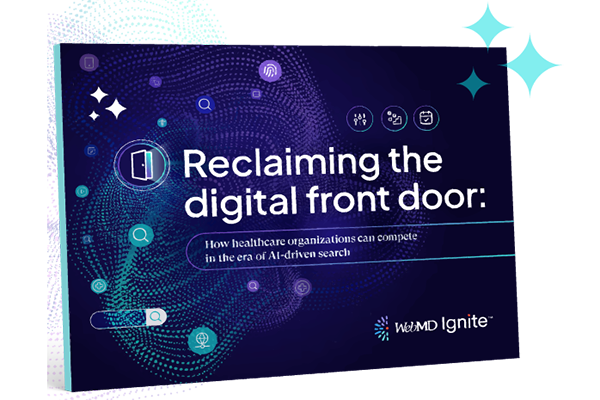5 Operational Healthcare Contact Center Metrics to Watch Closely

Categories: health plans, health systems, healthcare organizations, associations
Editor's Note: This blog was published prior to the transition to WebMD Ignite.
As a fundamental part of your health system’s digital front door, contact centers are a mainstay of any patient engagement and outreach strategy. Each day, a single agent can field anywhere from 50 to 100 calls, or more, from patients and consumers regarding a range of subjects, including prescription refills, appointment scheduling, class and event registrations, and general health concerns.
Since patients have many specific needs across numerous broad categories, measuring the success of healthcare contact centers is exceptionally challenging. Health systems need to invest in the technology, strategy, and processes necessary to promote a seamless, positive experience for every caller.
Thankfully, focusing on operational metrics helps overcome these blind spots by shining a light on any inefficiencies, redundancies, and shortcomings in your performance to provide a clear path to a better patient experience. Let’s take a closer look at what operational metrics are, and which metrics health system contact center leaders should focus on.
What are operational metrics?
Operational metrics are designed to minimize or eliminate sources of inefficiencies within your healthcare contact center. These metrics directly influence the patient experience, as they tend to examine if agents are meeting a caller’s standards in terms of expediency and effectiveness. For example, is a caller able to quickly have their needs met on a single call without being transferred, put on hold, or placed on a callback list?
Setting and maintaining a high standard for operational metrics is key to ensuring ongoing patient satisfaction. We recommend focusing on five important operational metrics: First call resolution, average hold time, average call handle time, abandonment rate, and forecasting accuracy.
1. First call resolution
First call resolution, or how many calls an agent completes without any transfers, holds, or callbacks, is important for contact center efficiency and caller satisfaction. It's frustrating to be transferred multiple times and repeat all of the background information ad nauseam.
Tracking this metric is relatively new to the healthcare industry — and it shows. Across all industries, 74% of all contact center outreach is resolved within the first call. However, in my experience, healthcare industry leaders have estimated that just 20% of calls are resolved on first touch. This shocking gap is partially due to a lack of focus on first call resolution but is also attributed to the complexity inherent in healthcare and limitations of tools currently in place at most hospital contact centers.
For instance, if a patient signs up for a seminar but is also interested in scheduling a consultation, they shouldn’t need to be transferred to a special scheduling department — from the consumer perspective, the agent that answers their call should be able to handle their request quickly.
While first call resolution rates should be monitored, some flexibility must be allowed due to the subjectivity of providing care. Coaching your agents will help your team understand how to improve first call resolution, or it will help you understand any legitimate reasons behind a transfer or callback. Start by identifying agents with a low first call resolution rate, then investigate a few of their calls and see if there are any important follow-up questions they could ask to eliminate the need for a second call. This will help your contact center be more efficient while providing a better patient experience.
2. Average hold time
Average hold time (AHT) is another common contact center metric. It measures the average time a customer spends on hold with an agent, both before and during the call. For a positive customer experience, it is important to minimize hold times.
General wisdom across industries states that a caller should spend no more than one minute on hold, but a good rule of thumb is 30-60 seconds. The logic is that the less time a caller spends on hold, the lower the call abandonment rate is. Fewer abandoned calls means more satisfied patients.
To lower your average hold time, use an agile patient engagement solution that is explicitly designed to help your agents respond to questions with great efficiency and accuracy. You should be able to access rich insights about a patient’s previous care experience and relevant inquiries in a single, 360-degree caller profile. This helps agents glean important information about the caller at a glance instead of putting them on hold while an agent wrangles information from disparate data sources.
However, sometimes placing a caller on hold is difficult to avoid. This is especially true for complicated questions that require agents to dive deep into the patient’s profile in search of answers. When some hold time is inevitable, make the process as painless as possible with music and messaging that won’t repeat more than once in a 30-second period. This will help ensure patients have a great experience, even when their questions are difficult to answer.
3. Abandonment rate
Keep a close eye on your abandonment rate, or how often a caller hangs up before they reach a contact center agent. Abandoned calls can have a significant impact on your health system’s success, since some callers will immediately pivot to a competitor if they don’t quickly receive assistance.
Across all industries, contact centers tend to experience a 13% abandonment rate. However, in our experience with healthcare call centers, an abandonment rate of approximately 5% is typical.
This may seem like a low number — but almost every abandoned call is avoidable and directly impacts your bottom line. To demonstrate the importance of minimizing abandonment rate, calculate it in the context of your own contact center. Take a close look at your average net revenue per visit versus your average caller-to-appointment conversation rate and total percentage of abandoned calls.
Then, determine how much revenue your healthcare system could recover by lowering your abandonment rate. Imagine your health system has 2,000 incoming calls each week, with 5% being abandoned. That’s 100 abandoned calls — and if 20% of those calls turn to a competitor instead of calling back, that's 20 lost patients. Lowering your total abandonment rate by just 1% will win you four new patients each week, putting money back into your health system’s coffers. For large health systems that handle tens of thousands of calls in a week, that small shift could represent millions of dollars in the course of a few years.
Remember that most people won’t wait on hold more than a minute, so speed to answer is directly related to the call abandonment rate. However, reducing speed to answer isn’t the sole responsibility of your agents. Ensure your contact center is adequately staffed so agents don’t feel immense pressure to answer inbound calls quickly. Then, help your agents by supplying rich patient insights stored in a single curated data lake to quickly and accurately address caller concerns. This will give them the tools they need to efficiently handle each call.
4. Average call handle time
Average call handle time is often characterized as how much time the agent spends on the phone with a customer. However, from an operational efficiency standpoint, both talk time and post-call work time should be considered when calculating average call handle time.
This metric used to be monitored quite closely for efficiency reasons, which would pressure agents to take shortcuts to handle the call as quickly as possible, and not necessarily as proactively as possible. This isn’t conducive to a high-quality experience. For example, if an agent spent an additional minute sending a patient several helpful resources and prevented a second call by doing so, they did their job well. However, with a strict measurement of average call handle time, the agent’s actions may be looked upon unfavorably.
Average call handle time shouldn’t be viewed as a primary quality indicator, but it is crucial to gaining context for unusually long or short calls. For example, an agent that handles calls in half the time of her coworkers shouldn’t be immediately praised without understanding if she's also offering the best possible caller experience — do her callers report feeling valued on post-call surveys? Is she calling them by their name? Is she asking relevant follow-up questions?
Agents shouldn’t be chastised for being proactive, even if it adds a few minutes to call handle time. However, if an agent is bogged down by ineffective technology, that additional time is not adding any value to the caller’s experience. Health systems must find ways to make finding and referencing patients’ details quick, seamless, and as reliable as possible. Unfortunately, many legacy contact center solutions can’t fulfill these requirements. By leveraging modern healthcare contact center technology, and features such as guided conversations, agents can cut down on unnecessary pauses during talk time while making post-call recordkeeping simple and efficient.
At the end of the day, there is no single ideal timetable that your agents should measure their handle time against. Rather, use this metric as a way to identify outliers who may need additional support in order to deliver an exemplary experience.
5. Forecasting accuracy
Forecasting accuracy refers to how well your health system predicts incoming call volume. This metric is essential to balance staffing in a way that ensures calls are answered promptly without giving agents excessive downtime. This has the effect of minimizing call abandonment and ensuring callers have a positive experience.
Start by investing in a good workforce management tool that can accurately forecast the average inbound and outbound call volume during a certain day of the week and time of day. Then, using historical call data, determine how many calls your agents tend to answer in a given timeframe. This will provide a clear picture of how many agents you need to handle call volume.
Additionally, you must have a symbiotic relationship between the marketing department and contact center to accurately predict call volumes. For example, you may receive 3,000 calls on a typical Tuesday. If marketing started promoting a new set of seminars to 75,000 patients in your market on Monday, you may need more agents available to respond to interested consumers. This helps ensure you’re scheduling the additional demand for your services rather than creating opportunities for a competitor.
Final thoughts
While tracking these five metrics won’t paint the full image of a successful or subpar call center experience, they shine a light on areas for improvement. For best results, track these metrics as key performance indicators over an extended period of time as they are extremely important to bolstering the patient experience.
However, operational metrics are only a single piece of the puzzle. Despite the increasing importance of patient satisfaction in today’s healthcare environment, many health systems neglect to invest in the technology that underpins the success of their contact center. By melding a strong strategy and efficient processes with powerful technology, your health system can rise above the rest and transform your contact center into a truly patient-centric, profitable engagement center.
This can be done by integrating multiple sources of patient and consumer data from your EHR, healthcare CRM, market insights solution, and other technology into a single, centralized patient profile. Then, use your engagement center solution to measure how well your agents align with your chosen benchmarks. These benchmarks can measure more than efficiency — some metrics measure the growth of your health system.
With a wealth of patient data available at your agents’ fingertips, your health system can count on them to deliver high personalized and efficient outreach.




